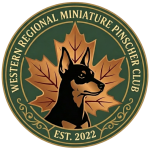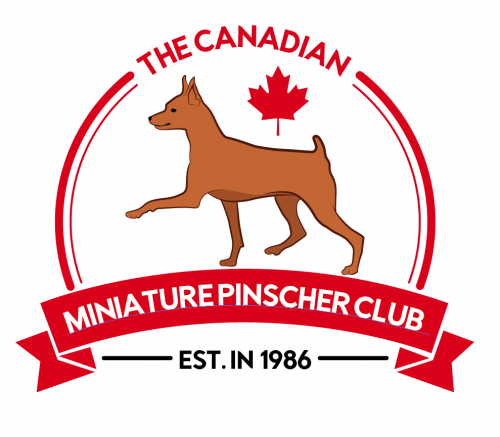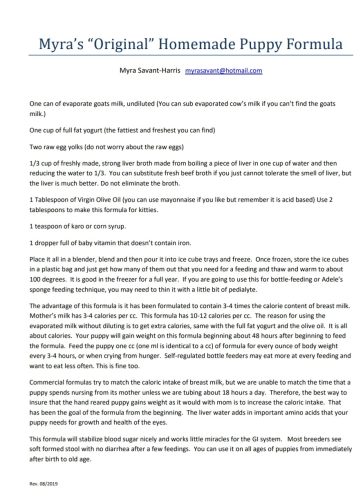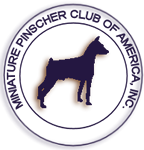www.DogWebsPremium.com – Website for your Kennel
www.DogWebs.Biz – Website for your Club or Business

 no current website
no current website
Mightymite Miniature Pinscher Growth Chart

Drug-Dosage-Chart for breeders, downloadable file. This file was created by a Vet’s office, however, I am not a vet myself. All dosages of ANY medication should ALWAYS be double checked by YOUR Vet first. Please use this chart at your own risk.

MINIATURE PINSCHER BREED STANDARD
July 2019
GROUP V TOYS, MINIATURE PINSCHER
Canadian Kennel Club Official Breed Standard
Miniature Pinscher
Origin & Purpose
The Miniature Pinscher originated in Germany several centuries ago
as an efficient barnyard ratter. The first breed standard was recorded
in the German Stud Book in 1880 and was officially recognized by
the Pinscher-Schnauzer Klub in Germany in 1895. In Canada the first
Miniature Pinschers were registered in the Canadian Kennel Club Stud
Book for the years 1937 – 1938.
General Appearance
The Miniature Pinscher is structurally a well-balanced, sturdy, compact,
short-coupled, smooth-coated dog. He naturally is well groomed,
proud, vigorous and alert. Characteristic traits are his hackney-like
action which is very important, fearless animation, complete self possession,
and his spirited presence.
Temperament
Fearless animation, complete self-possession, and spirited presence.
Size
10 inches (25.4 cm) to 12 1/2 (31.7 cm) inches in height allowed,
with desired height 11 (27.9 cm) inches to 11 1/2 (29.2 cm) inches
measured from the ground to the highest point of the shoulder blades.
All heights within the allowable range should be judged equally. Length
of males equals height at withers and Females may be slightly longer
when measured from ground to top of shoulder blade, and from point
of posternum to rear point of ischium.
Coat
Coat smooth, hard and short, straight, and lustrous, closely adhering to
and uniformly covering the body.
Colour
Solid clear red. Stag red (red with intermingling of black hairs). Black
with sharply defined rust-red or tan markings on cheeks, lips, lower jaw,
throat, twin spots above eyes and chest, lower half of fore legs, inside of
hind legs and vent region, lower portion of hocks and feet. Black pencil
stripes on toes. Chocolate with rust-red or tan markings the same as
specified for blacks, except brown pencil stripes on toes. In the solid
red and stag red, rich vibrant medium to dark shade is preferred.
Head
In correct proportion to the body. Tapering, narrow with well fitted but
not too prominent foreface which balances with the skull. Skull appears
flat, tapering forward toward the muzzle. No indication of coarseness.
Head well balanced with only a slight drop to the muzzle which is
parallel to the top of the skull. Muzzle strong rather than fine and
delicate, and in proportion to the head as a whole. Lips: smooth and
tight-fitting to the jaws. Corners of the lips closed. Throat skin tightfitting
without folds. Nose black only, with the exception of chocolates
which should have a self-colored nose. Teeth meet in a scissors bite.
Eyes full, slightly oval, clear, bright and dark even to a true black,
including eye rims, with the exception of chocolates, whose eye rims
should be self-colored. Ears set high, standing erect from base to tip.
May be cropped or uncropped. Drop ears should be set high, V-shaped
with the inner edges lying close to the cheeks, turned forward towards
temples. Folds parallel, should not be above the top of the skull.
Neck
Proportioned to head and body, slightly arched, gracefully curved,
blending into shoulders, muscular and free from a suggestion of
dewlap or throatiness.
Forequarters
Shoulders: clean and sloping with moderate angulation, co-ordinated
to permit the Hackney-like action. Elbows: close to body. Legs:
strong bone development and small clean joints. As viewed from the
front, straight and upstanding. Pasterns: strong and perpendicular.
Dewclaws should be removed. Feet small, catlike, toes strong, well
arched and closely knit with deep pads. Nails thick, blunt.
Body
Topline: Back level or slightly sloping toward the rear both when
standing and gaiting. Body compact, slightly wedge-shaped, muscular.
Forechest well developed. Well-sprung ribs. Depth of brisket, the
base line of which is level with points of the elbows. Belly moderately
tucked up to denote grace of structural form. Short and strong in loin.
Croup level with topline. Tail set high.
Hindquarters
Well-muscled quarters set wide enough apart to fit into a properly
balanced body. As viewed from the rear, the legs are straight and
parallel. From the side, well angulated. Thighs well-muscled. Stifles
well defined. Hocks short, set well apart. Dewclaws can be removed.
Feet small, catlike, toes strong, well arched and closely knit with deep
pads. Nails thick, blunt.
Tail
Docked: Set high, held erect, docked to 1/2 – 1 inch (1-3 cm). Natural:
a sabre (set high and held erect) or sickle (set high and held slightly
curling over the back) tail carriage.
Gait
The forelegs and hind legs move parallel with feet turning neither in
nor out. The hackney-like action is a high-stepping, reaching, free and
easy gait in which the front leg moves straight forward and in front of
the body and the foot bends at the wrist. The dog drives smoothly and
strongly from the rear. The head and tail are carried high.
Faults
• Structurally lacking in balance, timid or dull, shy or vicious.
• Poor in action (action not typical of the breed requirements).
• Head too large or too small for the body, too coarse or too refined.
• Nose any colour other than black (with the exception of chocolates
which may have a self-coloured nose)
• Bite overshot or undershot
• Light coloured eyes are not desirable
• Loose, flabby or wrinkled skin on neck
• Forequarters: Shoulders too straight, too loose or too short
• Forelegs bowed or crooked
• Weak pasterns
• Feet turning in or out
• Loose elbows
• Body: Too long, too short, lacking in body development, sway
back, roach back, or wry neck
• Forechest not dropping to elbows
• Spring of rib too narrow (or too shallow and underdeveloped)
• Lacking tuck up
• Tail set too low, drooping or hanging
Disqualifications
• Under 10 inches (25.4 cm) or over 12 ½ (31.7 cm) inches in height
• Any colour other than listed, specifically light blue and rust, dark
blue and rust, blue and tan, fawn and rust, Isabella fawn and fawn
with tan points
• Thumb mark (patch of black hair surrounded by rust on the front
of the forelegs between the foot and the wrist; on chocolates, the
patch is chocolate hair).
• White on any part of dog which exceeds one half (1/2) inch in its
longest dimension.

